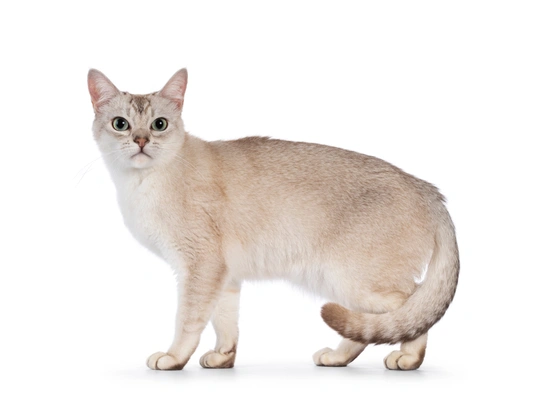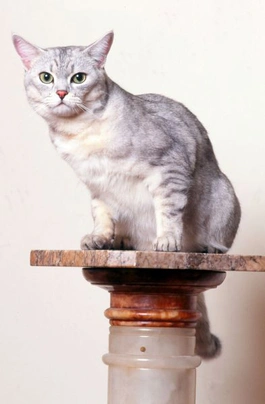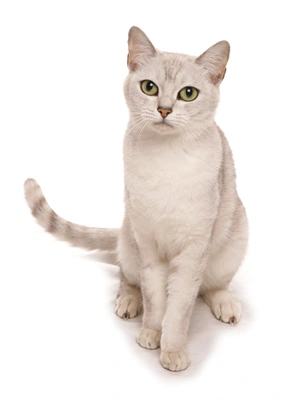Burmilla
Introduction of the Burmilla
The Burmilla often referred to as an Asian Shaded originated in the UK in 1981 as the result of an 'accidental' mating between a Persian Chinchilla and a Burmese. Although this is a breed in its own right in that it breeds 'true' (i.e. Burmilla x Burmilla will produce only Burmilla offspring) it is also the founder breed of the overall group of cats known by the Governing Council of the Cat Fancy (GCCF) as the Asian Group which is used for cats of Burmese shape and coat texture but with non-Burmese coat colour pattern or length. This closely-linked group of cats which derive from Burmese crossed with other pedigree breeds also includes the Asian Self Asian Smoke Asian Tabby Bombay (a black Asian Self) and the Tiffanie (a longhaired Asian variety). The offspring of cross-mating Burmese and Chinchilla parents always produces these shorthair silver offspring carrying two recessive genes - the 'self' gene inherited from the Burmese and the 'longhair' gene inherited from the Chinchilla. Interestingly the Asian Group were the first pedigree cats breeds in Britain to include a good temperament as part of their Standard of Points.
History of the Burmilla
The history of all Burmilla cats in the UK can be traced back to two cats owned by Baroness Miranda von Kirchberg who was well known for her Astahazy breeding prefix. She had bought a male Chinchilla kitten Jemari Sanquist (bred by Rosemary Gowdy breeder of the famous Kosset Carpet cats) to be a pet for her husband but before the kitten was neutered unknown to her he mated one of her Burmese female cats Bambino Lilac Fabergé (bred by Barbara Boizard-Neil). The resulting four female kittens were born in September 1981 all black shaded silver of good Burmese type. The breeder decided to develop this new breed giving it the name of Burmilla that was a combination of the two parent breeds and along with other breeders who soon became interested she led the campaign to get the Burmilla recognised by the GCCF which she achieved in 1989. Throughout the breeding programme these lovely cats have been bred back to pure Burmese (often alternate generations in the early days) to maintain the wonderful Burmese type coat texture and temperament and nowadays there are a good number of breeders promoting the Burmilla in the UK. There have been separate Burmilla breeding programmes in the USA although different lines of Chinchilla and Burmese have been used and they are not descended from the UK lines. Their popularity has also spread into northern Europe and especially to Scandinavia.
Appearance of the Burmilla
The Burmilla is a very attractive shorthaired cat of 'foreign type' and medium size with the coat demonstrating a striking contrast between the Shaded or Tipped topcoat and a basecoat of either pure silver white or non-silver (also known as Standard) which is ivory or beige. Although the original Burmillas were all black shaded silver the coat colours have diversified over the past thirty years and the shading or tipping can now be in any of the following colours - black/brown blue chocolate lilac red cream black/brown tortie blue tortie chocolate tortie or lilac tortie giving a spectrum of 20 variations in terms of colour and coat pattern. As in the parent breeds of Chinchilla and Burmese there are no tabby Burmillas as such although faint ghost markings are usually seen more noticeably so in kittens. Many breeds have nose leather that corresponds to the coat colour but in the Burmilla it is a distinctive shade of terracotta apart from the reds and creams where it is pink and the tortie where it matches the main coat colour or is pink or is a combination of the two. The large expressive eyes are truly magnificent and are a clear luminous green in colour although amber is acceptable in reds creams and torties.
Temperament of the Burmilla
The Burmilla has an enchanting temperament and combines the extrovert characteristics of the Burmese with the more relaxed and laid back attributes of the Chinchilla. Like most breeds young Burmilla kittens are very playful and mischievous but will develop into a very intelligent and affectionate cat. However the Burmese tendencies are still there in the background and an adult Burmilla is very capable of opening door and cupboards to see what's there and they enjoy playing with a wide range of toys often retrieving things that are thrown for them and 'stealing' items that look fun to play with. They love attention and being part of active family life and can be quite demanding if they not get the attention they want - it is often advisable for the Burmilla to have feline company for the times when their humans are out but in return there will be double the entertainment value! They generally get on very well with other family pets and cope admirably with the sometimes over-enthusiastic handling by young children. They also have the ideal temperament for cat shows as they thrive on all the attention and admiration there.
Intelligence / Trainability of the Burmilla
The Burmilla appears to be a long-lived variety with no health problems specific to the breed. In common with other cats they need annual vaccination boosters against the common feline ailments of flu and enteritis as well as against Feline Leukaemia if they go outdoors.
Children and other
The Burmilla will eat most good quality proprietary brands of cat food but will also enjoy treats of cooked chicken ham and grated cheese preferably shared with its humans if care is not taken! However cows' milk will probably give them a stomach upset and a bowl of water should always be available. Their coats will not need much grooming and stroking will normally remove any dead hairs although a weekly combing will help to keep the coat in tiptop condition. The Burmilla loves its home comforts and will be perfectly happy living indoors with its adoring owners.
Health of the Burmilla
Caring for the Burmilla
Grooming of the Burmilla
Exercise of the Burmilla
Feeding of the Burmilla
Burmilla price



